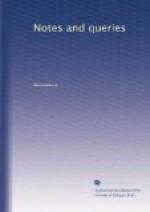2. In Lewis’s History of the Translations of the Bible, edit. 1818. p. 25., he quotes a work of Bishop Bonner, “Of the Seven Sacraments, 1555,” in which a manuscript English Bible is cited by the Bishop, as then in his possession, “translated out of Latyne in tyme of heresye almost eight-score years before that tyme, i.e. about 1395, fayre and truly written in parchment.” Lewis proceeds to conjecture, that this MS. was the same which is preserved in the Bodleian Library under the mark Fairfax, 2. And in this erroneous supposition he has been followed by later writers. The copy in question, which belonged to Bonner, is actually in the Archiepiscopal Library at Lambeth, No. 25., and contains the Pentateuch in the earlier Wycliffite version (made, no doubt, by Nicholas Hereford), whilst the rest of the Old and New Testament is in the later or revised translation by Purvey and his coadjutors. What I now wish to inquire about, is, where can I meet with a copy of Bonner’s work, De Septem Sacramentis, in which the passages occur referred to by Lewis? They are not in A Profitable and Necessarye Doctryne, with certayne Homelies adjoyned, printed in 1555 by John Carood, although one of these homilies is on the subject of the seven sacraments.
F. MADDEN.
* * * * *
MINOR QUERIES.
Monastery, Arrangement of One.—Any information and particulars respecting the extent, arrangement, and uses of the various buildings for an establishment of fifty Cistercian or Benedictine Monks would be useful to and gratefully received by
A.P.H.
[Has our Querist consulted Professor Willis, “Description of the Ancient Plan of the Monastery of St. Gall in the Ninth Century,” accompanying a copy of the plan, and which he will find in the Archaeological Journal, vol. v. p. 85.?]
Constantine the Artist.—Who was “M. Constantine, an Italian architect to our late Prince Henry,” employed in the masque at the Earl of Somerset’s marriage in 1613? and was he the same Constantine de Servi to whom the Prince assigned a yearly pension of 200l. in July 1612? If so, where can more be found respecting him? He is not mentioned on Walpole’s Anecdotes.
J.G.N.
Josias Ibach Stada.—Who was the artist whose name occurs inscribed on the hoof of the horse of King Charles the Second’s equestrian statue at {453} Windsor, as follows:—“1669. Fudit Josias Ibach Stada Bramensis;” and is Mr. Hewitt, in his recent Memoir of Tobias Rustat, correct in calling him “Stada, an Italian artist?”
J.G.N.
Worm of Lambton.—Is there any published notice of the “Knight and Serpent” tradition regarding this family and parish?
A.C.
[A quarto volume of traditions,
gathered in the immediate
neighbourhood of the scene
of action, was privately printed in
the year 1530, under the title
of The Worm of Lambton.]




